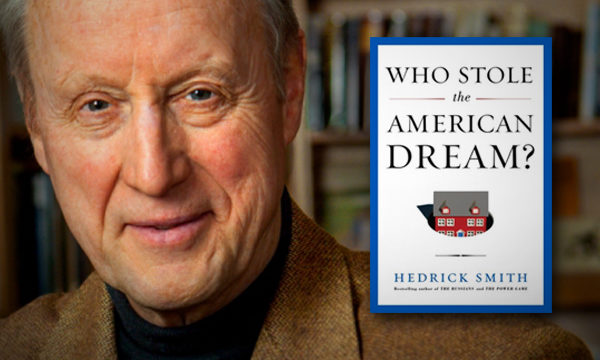By Llewellyn King
The middle class has been taking a shellacking for years. It began in the 1970s, when the business and political elites separated from the people and it has been accelerating ever since, according to Hedrick Smith, a former Pulitzer Prize-winning New York Times reporter and editor, an Emmy award-winning PBS producer and correspondent, and a bestselling author. In short, an establishment figure.
Add to Smith’s establishment credentials schooling at Choate, the private boarding school, a stint at Oxford, and you have the picture of someone with the credentials to join the elite of his choosing. Instead Smith is a one-man think tank, a persuasive voice against the manipulation of the public institutions, like Congress, for money and power.
But Smith is not a polemicist. He uses the reporter’s tools, honed over decades in Moscow and Washington and on big stories, like the civil rights movement and the fall of the Soviet Union, to make his points against the assault on the middle class.
It all began with Smith’s looking into what was happening to American manufacturing, which led to his explosive 2012 book, “Who Stole the American Dream?” Encouraged by the book’s success, he created a Web site, reclaimtheamericandream.org, which now has a substantial following. In the past three years, he has lectured at over 50 universities and other platforms on his big issue: the abandonment of the middle class by corporate America and its corrupted political allies.
Smith documents the end of the implicit contract with workers, where they shared in corporate growth and stability. He outlines how money has vanquished the political voice of the middle class.
Instead, according to Smith, corporations have knelt before the false god of “shareholder value.” This has resulted in the flight of corporate headquarters to tax-friendlier climes, jobs to cheap labor, and a managerial elite indifferent to those who built the companies they manage.
In Smith’s well-researched world it is not only the corporations that have abandoned the workers, but the political establishment is also guilty, bowing to lobbyists and fixing elections through redistricting. Two villains here: money in politics and gerrymandering electoral districts.
The result is a democracy in name only that serves the powerful and perpetuates the power of those who have stolen the system from the voters.
Smith cites the dismal situation in North Carolina, where districts have been drawn ostensibly to ensure black representation in Congress, but also to ensure Republican domination of all the surrounding districts. The two districts that illustrate the mischief are called “the Octopus” and “the Serpent” because of the way they are drawn to identify the voter preference of the inhabitants.
The rise of Bernie Sanders and Donald Trump are testament to the broken system, says Smith. They are symbolic of the rising up of the middle class against the predations of the elites.
But Smith is hopeful because, he says, the states have taken up arms against the Washington and Wall Street elites. People should “look at the maps,” he says, “They will be surprised to find out that 25 states are engaged in a battle against partisan gerrymandering, or that 700 cities and communities plus 16 states are on record in favor of rolling back ‘Citizens United’ and restoring the power of Congress to regulate campaign funding.”
Smith sees the middle class reclaiming America: a great social revolution that again unites the government with governed, the creators of wealth with the managers of the wealth. Smith is no Man of La Mancha, tilting at windmills, but a torchbearer for a revolution that is underway and overdue.
“My thought is that more people would be emboldened to engage in grassroots civic action if they could just see what other people have already achieved,” he told me.
Smith’s Web site has drawn 82,000 visitors in the past year, and Facebook posts have reached 2.45 million, he says.
Smith cautioned me to write about the Web site and cause and not the man. But the man is unavoidable, and unique. He has as much energy as he had when I first met him in passing in a corridor at the National Press Club in Washington decades ago. At 82, Smith still plays tennis, skis, hikes, swims and dances with his wife, Susan, whom he describes as a “gorgeous dancer.”
At 6 feet 2 1/2 inches, Smith is an imposing figure at the lectern, but his delivery is gentle and collegiate: a reporter astounded and pleased with what he has found in the course of his investigation of the American body politic. — For InsideSources

 Follow
Follow
Leave a Reply